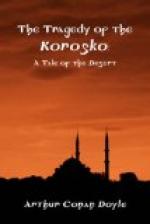CHAPTER I.
The public may possibly wonder why it is that they have never heard in the papers of the fate of the passengers of the Korosko. In these days of universal press agencies, responsive to the slightest stimulus, it may well seem incredible that an international incident of such importance should remain so long unchronicled. Suffice it that there were very valid reasons, both of a personal and of a political nature, for holding it back. The facts were well known to a good number of people at the time, and some version of them did actually appear in a provincial paper, but was generally discredited. They have now been thrown into narrative form, the incidents having been collated from the sworn statements of Colonel Cochrane Cochrane, of the Army and Navy Club, and from the letters of Miss Adams, of Boston, Mass.
These have been supplemented by the evidence of Captain Archer, of the Egyptian Camel Corps, as given before the secret Government inquiry at Cairo. Mr. James Stephens has refused to put his version of the matter into writing, but as these proofs have been submitted to him, and no correction or deletion has been made in them, it may be supposed that he has not succeeded in detecting any grave misstatement of fact, and that any objection which he may have to their publication depends rather upon private and personal scruples.
The Korosko, a turtle-bottomed, round-bowed stern-wheeler, with a 30-inch draught and the lines of a flat-iron, started upon the 13th of February in the year 1895, from Shellal, at the head of the first cataract, bound for Wady Halfa. I have a passenger card for the trip, which I here reproduce:
S.W. “Korosko,”
February 13th.
Passengers.
Colonel Cochrane Cochrane London.
Mr. Cecil Brown London.
John H. Headingly Boston, U.S.A.
Miss Adams Boston, U.S.A.
Miss S. Adams Worcester, Mass., U.S.A.
Mons. Fardet Paris.
Mr. and Mrs. Belmont Dublin.
James Stephens Manchester.
Rev. John Stuart Birmingham.
Mrs. Shlesinger, nurse and child Florence.
This was the party as it started from Shellal, with the intention of travelling up the two hundred miles of Nubian Nile which lie between the first and the second cataract.
It is a singular country, this Nubia. Varying in breadth from a few miles to as many yards (for the name is only applied to the narrow portion which is capable of cultivation), it extends in a thin, green, palm-fringed strip upon either side of the broad coffee-coloured river. Beyond it there stretches on the Libyan bank a savage and illimitable desert, extending to the whole breadth of Africa. On the other side




